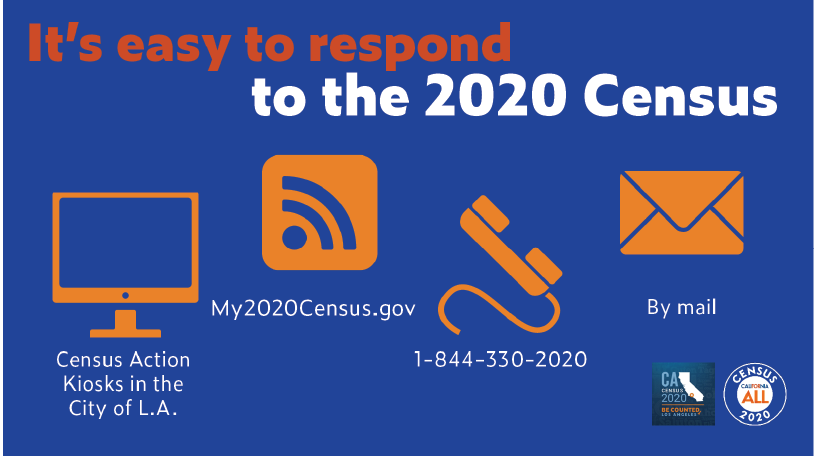
-
Category:
- Communities
What is the Census?
The Census is our nationwide headcount that is required by the Constitution to take place every 10 years. The Census plays an essential role in American democracy, and the results in 2020 will shape the future of our community and our voice in Congress. Federal funding, allocation of social services, and decisions about where to invest and build are guided by the Census, so it’s important that everyone living in the U.S. is counted to accurately reflect who and where we are.
The first U.S. Census was conducted in 1790, and the questionnaire has evolved over the decades. In 2020, the Census asks your name, age, date of birth, sex, race/ethnicity, and whether you rent or own your home; it also asks those questions of everyone in your household. (You can preview the questions here.) The 2020 Census will not ask about any person’s citizenship status.
Starting March 12, 2020, the Census will be available online at My2020Census.gov, but that is just one of the ways you can complete the Census. Find more details at the end of this article.
How does LA City Planning use the Census?
LA City Planning uses a combination of data from the Census and other surveys conducted by the U.S. Census Bureau (such as the American Community Survey) to create demographic profiles of the City and each Community Plan Area. These reports help planners understand the communities we serve and how those communities have changed over time.
Planners regularly look at factors such as age, race/ethnicity, household size, and renter and ownership rates when updating Community Plans or individual elements of the General Plan, including the Housing Element and the Mobility Plan. This data informs neighborhood-specific planning efforts, too. We also use demographic information from the Census to help us plan inclusive and effective outreach strategies.

What other ways does the Census affect Planning?
The Census determines money and power, and California and Los Angeles have a lot to gain and a lot to lose. Based on the Census, California currently receives about $115 billion every year in federal funding for education, healthcare, housing and other social safety net programs. The County of Los Angeles receives approximately $7 billion of that each year.
These funds make many widely-recognized federal programs available, including Section 8 housing vouchers, Low Income Housing Tax Credits (for the construction of affordable housing), transit and highway planning grants, school lunches, SNAP (food stamps), and more. Implementing these programs across Los Angeles addresses some of the goals and policies laid out in the City’s General Plan, in documents such as the Housing Element, Mobility Plan 2035, Plan for a Healthy Los Angeles, and the 35 Community Plans.
The census also determines political representation. The number of representatives each state has in the U.S. House of Representatives may change after the 2020 Census based on population distribution. In addition, redistricting will occur at all levels of government, including the U.S. Congress, California State Assembly, and Los Angeles City Council.
Although a complete count is extremely important, the County of Los Angeles is considered the hardest-to-count in the nation. The population size, complex diversity, language barriers, housing insecurity, number of people experiencing homelessness, and other local factors make Los Angeles one of the most difficult places in the country to count accurately. When people in Los Angeles are not counted, we miss out on our fair share of funding and representation in Congress, and communities that have historically been under-counted continue to be under-recognized in official statistics.
How do I complete the Census?
Responding to the Census is easy!
- You can complete the Census online, by telephone, or via mail.
- The Census is available online and by phone in English and 12 non-English languages. Guides for other languages are available here.
- To respond online, go to My2020Census.gov on your own internet-ready computer, smartphone, or tablet, or find the Census Action Kiosk nearest you (learn more at census.lacity.org).
2020 Census Timeline:
- March: Invitations are mailed out asking households to respond to the new online census. Reminder letters go out towards the end of the month.
- April: Reminder postcards go to households that haven’t responded online. You may receive a reminder letter and paper questionnaire if you have not responded by their fourth reminder.
- May-July: Census takers will begin visiting homes that haven’t responded to the 2020 Census to help make sure everyone is counted. The last day to respond is July 31, 2020.
Only one person in each household needs to complete the Census, but make sure to count everyone in your household!

Please help us spread the word about the importance of the 2020 Census. You can visit the City's Census website right now for additional information about local efforts, and starting March 12, you can visit the U.S. Census Bureau’s My2020Census.gov page to complete the Census online.
Be counted, Los Angeles!
Emily Gable, City Planner
Citywide Policy Planning